Short Communication - (2022) Volume 11, Issue 2
In this paper, we will discuss affecting factors on concentration of blood flow from different types of the compartment in the cells. If injecting to the body using drug sample, then it effects on the rate of concentration in blood cells and tissues i.e. we are changing rate of the flow of the blood which effects on the impurities added in blood cells. We are analyzing this technique using a mathematical model as differential equation tool and we have found out equilibrium point with the stability model. Here we have discussed two models Model-I and Model-II with their existence of equilibrium and stability. Computation of the drug concentration in the different compartments has been found by using numerical data. Data accessed by using MATLAB simulation and plotted the graphs for variation of drug concentration with respect to time
Rate of flow of blood • Differential equation • Equilibrium point • Satiability • Eigen values
To find stable solution of estimate the drug concentration at different sites and within the blood. When the drug is administered orally or by injected into the body, it dissolves in the blood and releases the medications into the gastrointestinal tract. The flow of drugs within the body is modulated by treating the different parts of the body as compartments and then tracking the medication as it enters and leaves each compartment. The drug leaves one compartment and enters into another one at the rate proportional to the concentration of drug present in the first compartment. It starts the medications diffuse blood cells to tissue cells and vice versa. The constant of proportionality is mainly determined by the drug, the compartment and general health of the individual (Figures 1-6).
If c(t) denotes the concentration of drug in the compartment at time t, then the rate of change of c(t) is:

Main Result
Basic Solution of linear differential equation with mathematical model

Can be found by applying particular solution method, In order to formulate a mathematical model for the blood flow due to drug absorption, we have considered two different models Model-I and Model-II.
In this model, only two compartments viz. blood and tissue were identified as the main exchangers. The first one is the blood stream into which the drug is injected and the second one is the tissue where the drug has the therapeutic effect. We assume that blood takes a part of drug at the rate of Kb onto tissue, from tissue compartment to the venous blood with the rate of Kt and Ke is clearance rate (eliminated from blood). Let C(t) and Ct(t) denote the concentration of drug in the compartments of blood and tissue respectively and C0 be the initial concentration of drug injected through intravenous route the body [1]. Then the mathematical form of two compartment model describing the drug administration is as shown in Figure 1.
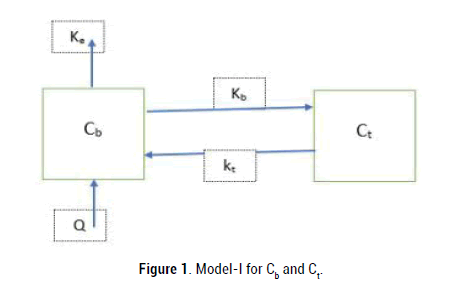
Figure 1: Model-I for Cb and Ct.
Thus the mathematical formulation in this case is governed by the system of ODEs, each equation describing the rate of change of drug concentration with respect to time in their respective compartments as [2].
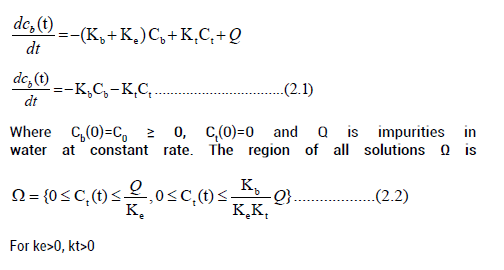
This model (2.1) has the following two nonnegative equilibrium in Ω as

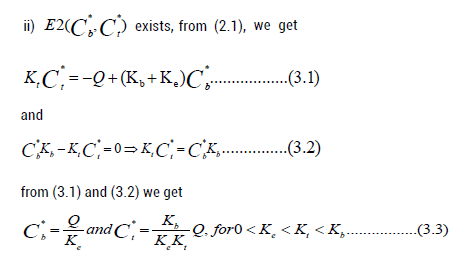
by using simulink in MATLAB and plotted the graphs for variation of drug concentration with respect to time [3,4]. Equilibrium point for particular time with respective to particular values Time t=5.1766, Cb=Ct=39.1236. Clearly we get observation in Figures 2 and 3.
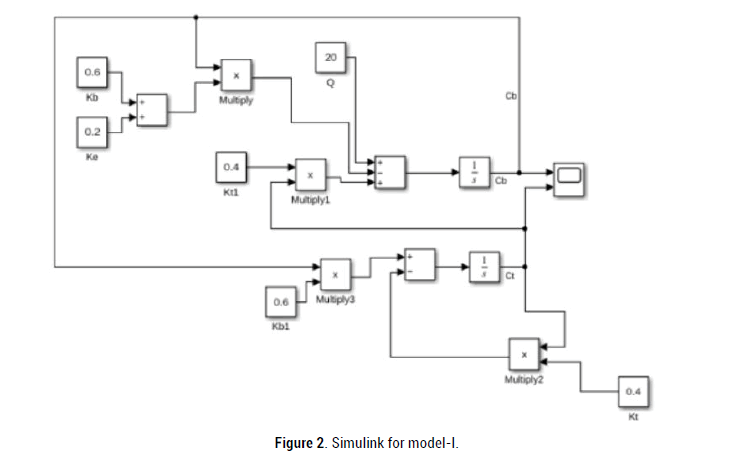
Figure 2: Simulink for model-I.
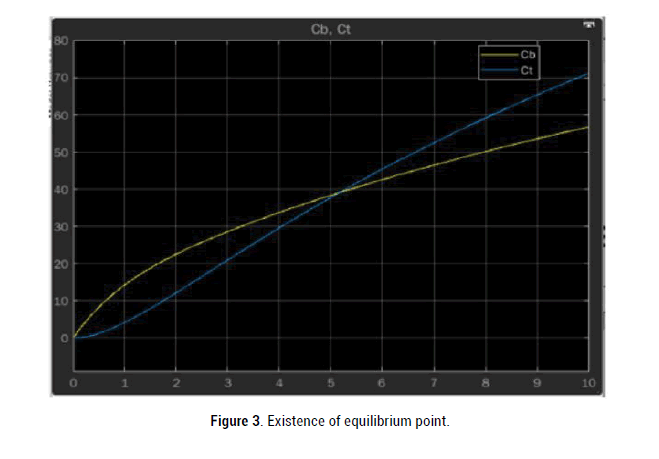
Figure 3: Existence of equilibrium point.
1) For Cb = 0 ⇒ Ct = 0
2) For Kb ⇒ ∞ ⇒ Ct ⇒ ∞
3) For Ke ⇒ 0 ⇒ Cb ⇒ 0

Therefore equations from (3.1) intersect in interior of the positive quadrant, hence this Model-I has non-negative equilibrium ( Cb*,Ct* ).
The stability of the given system (2.1) around each of the equilibrium is obtained by computing the vibrational matrix J corresponding to each equilibrium point. The Jacobian matrix corresponding to the system (2.2) is given below,

Stability depends on the Eigen values of the matrix (3.2) with characteristic equation gives solution.

In both cases eigen values are negative showing stability of the system. Theorem 4.1. The equilibrium E(Cb*,Ct*) is stable.
Assume that the consumption of drug by arterial blood towards tissue flows at the rate of Kb and from tissue compartment to the venous blood with the rate of Kt. Let Ke be the clearance rate of drug from the blood [4-6].
Let Cab (t), Ct (t) and Cvb(t) denote the concentration of drug in the arterial blood, tissue and venous blood compartment respectively with C0 as initial drug dosage [7,8]. Graph of the model is Figure 4.
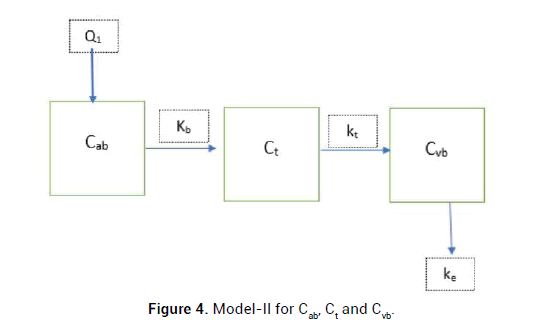
Figure 4: Model-II for Cab, Ct and Cvb.
The mathematical model for the drug concentration with respect to these compartments with initial conditions
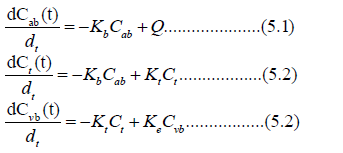
with Cab(0)=C0, Ct(0)=0, Cvb(0)=0 and Q is impurity in water at constant rate from arteries and venous. The region of all solutions Ω is

For Ke<Kt<Kb
This model (5.1) has the following two nonnegative equilibrium in Ω as
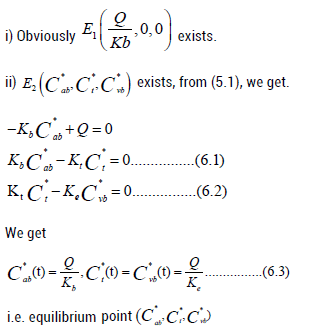
By using simulink in matlab Figures 5 and 6.
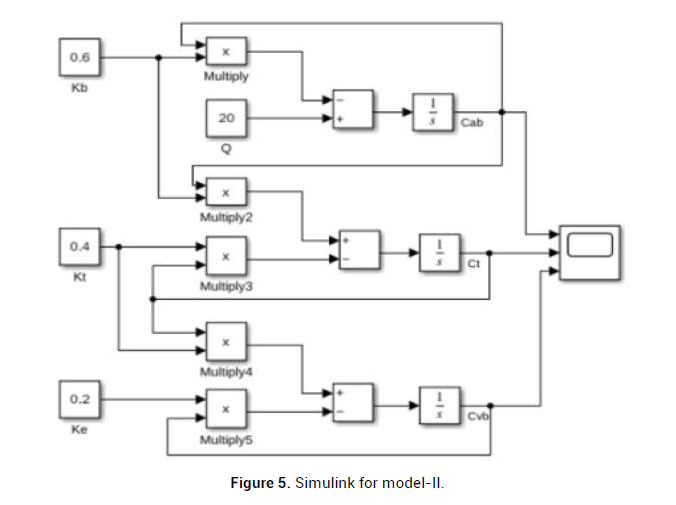
Figure 5: Simulink for model-II.
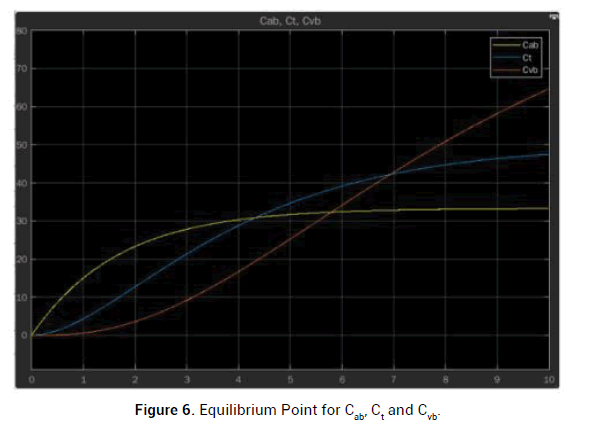
Figure 6: Equilibrium Point for Cab, Ct and Cvb.
We get equilibrium Points for perticular points
(1) Cab and Ct: Time: t=4.3199, Cab= Ct=30.8333
(2) Cab and Cvb: Time: t=5.7940, Cab= Ct=32.3026
(3) Cvb and Ct: Time: t=6.9311, Cvb=Ct=432.1826
It is observed:
1) For Model-I, it is clear that concentration of drug decreases with respect to the absorption of drug in all compartment. Also from Figures we get existence of equilibrium point of concentration.
2) From Model-II, it is clear that concentration of drug decreases with respect to the absorption of drug in all compartment. The drug concentration goes on changing patient to patient depend on the condition of patient then also rate of absorption goes to stability.
From formulation of Model-I and II both are working models and applicable for the pharmaceutical and medical field for understanding diffusion of blood flow due to drug concentration.
The authors wish to thanks RUSA for providing financial support under RUSA MRP Sanction letter No: 629 2020-2021.
Citation: Gajanan D, et al. Mathematical Model of Rate of Blood Flow and Diffusion due to External and Internal Solution. J Biol Today's World, 2022, 11(2), 001-004
Received: 10-May-2022, Manuscript No. JBTW-22-63407; Editor assigned: 13-May-2022, Pre QC No. JBTW-22-63407 (PQ); Reviewed: 27-May-2022, QC No. JBTW-22-63407; Revised: 03-Jun-2022, Manuscript No. JBTW-22-63407 (R); Published: 10-Jun-2022, DOI: 10.35248/2322-3308-11.2.001
Copyright: © 2022 Gajanan D, et al. This is an open-access article distributed under the terms of the Creative Commons Attribution License, which permits unrestricted use, distribution, and reproduction in any medium, provided the original author and source are credited.